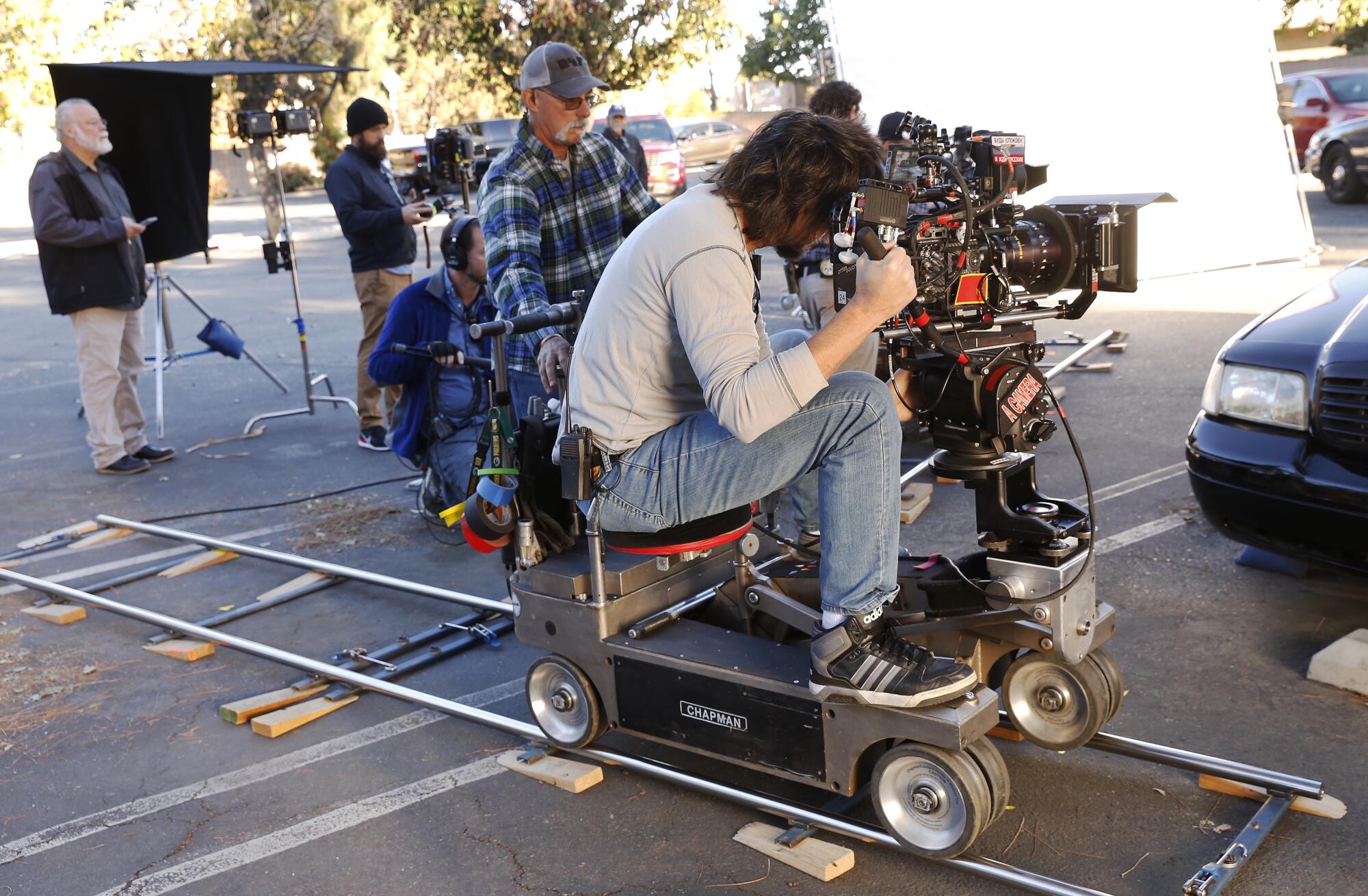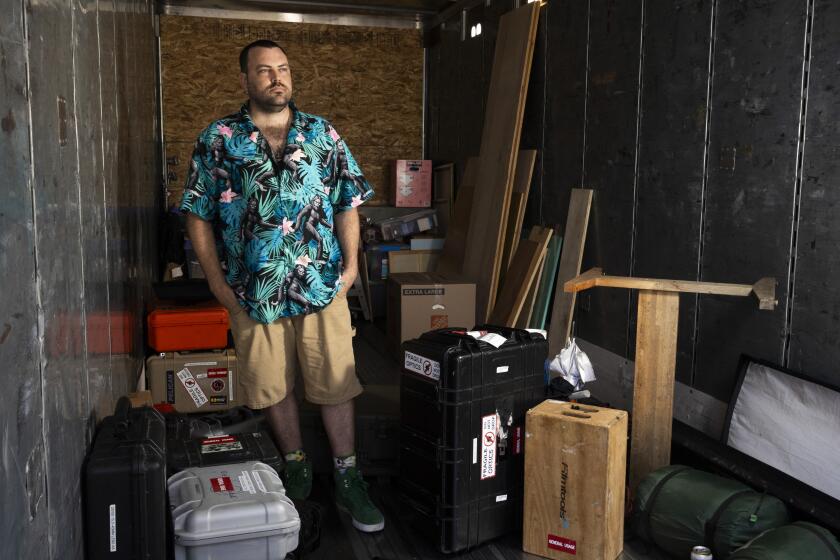
- Share via
- California is experiencing a crisis in its homegrown film and TV business that has struggled
to recover from the pandemic and strikes last year. - Industry experts say that boosting state film and TV tax credits is necessary, but securing a big increase in funds is unlikely.
- Others have proposed more modest steps, such as lowering film permit fees and providing free police services on sets.
In 2021 Vince Gervasi, president and chief executive of Triscenic Production Services, saw an opportunity.
For nearly four decades, the Santa Clarita-based company has been the largest provider of set and scenery storage, transportation and other services for the entertainment business. With the industry still in the throes of a streaming surge and the number of productions filmed in Los Angeles increasing dramatically, the company built seven soundstages.
Three years later, Triscenic — like many other local businesses — is contracting. Over the last 19 months, only one of those soundstages has been in use. The once-humming facility that housed sets across 2 million square feet in 41 buildings has been culled to half that size. In July, Gervasi laid off 78 of his 85 employees.
“I was able to carry them through the strike,” he said, “but the fact is that nothing is going on in this industry. There are no shows coming in.”
As Hollywood contends with one of its worst production downturns in decades, many are asking the same pointed question: Can California do more to jump-start its homegrown industry, one that has been buffeted by pandemic shutdowns, last year’s strikes by writers and actors, technological shifts and mounting global competition?
The answer is a resounding “yes,” but the solutions are neither easy nor assured, according to interviews The Times conducted with dozens of producers, business owners, studio executives and film crew workers.
Industry members and experts agree that, first and foremost, a heaping monetary boost to California’s film and TV tax credit program is much needed to compete with incentives offered elsewhere. But it’s also widely acknowledged that such a boost will be difficult — if not impossible — to obtain.
Others have proposed more modest steps, such as lowering film permit fees in Los Angeles and providing free police services on sets.
Underscoring the sense of urgency, Los Angeles Mayor Karen Bass has convened a task force to address ways of helping the industry.
“Let’s get some film professionals in and let’s take their advice. Because this is a crisis, and we need all hands on deck,” said Chris Fuentes, a veteran location manager whose credits include “Good Trouble” and “The Big Lebowski.”
Despite differences over solutions, there is a consensus on the problem: California is simply not competitive with many other states and countries that offer more generous incentives to entice film crews.
Mike DeLorenzo, president of Santa Clarita Studios, said this is the “slowest period” that he has experienced in more than four decades. Before last year’s strikes, DeLorenzo told The Times, 35 of his 37 soundstages were booked. That number has since fallen to 10.
“I believe the best filmmakers in the world are right here in Los Angeles, but it’s being outsourced because of the tax credits,” DeLorenzo said. “I’m not competing with Universal [Studios] or Warner Bros. or another huge, beautiful facility. I’m competing against Canada, and I’m competing against New York and I’m competing against Mexico. And that’s difficult.”

These days, studios even have their own incentives departments that steer location managers and scouts to regions that offer the best deals.
Lori Balton, a longtime location scout whose resume includes the movies “Top Gun: Maverick” and “Inception,” said that recently studios have been pushing destinations in Central Europe such as Hungary.
“I used to get a script, and they’d say, ‘Go out and find where we can shoot this,’” Balton said. “Now I get a script, and they say, ‘Here are the incentive states. This is where we want you to look.’”
Bill Mechanic, the former chairman of 20th Century Fox, said he didn’t even consider filming in California for his last movie, the Academy Award-nominated “Hacksaw Ridge,” or his upcoming crime thriller, “The Dain Conspiracy” — instead choosing to take both productions to Australia.
“Would I prefer to shoot here? Yes,” he said. “But you go where the money is.”
The fallout from peak TV’s decline is being felt strongly by writers, who face fewer opportunities as entertainment companies merge and cut back offerings.
The flight of production
The problem of so-called runaway production galvanized a coalition of labor and union groups to create the state’s first tax credit in 2009, a modest incentive providing $100 million annually for five years. Backed by actor and then-Gov. Arnold Schwarzenegger, the legislation was dubbed the “Ugly Betty” bill, after the ABC sitcom that moved from Los Angeles to New York.
Five years later, when the industry hit another crisis point, the program was increased to $330 million a year, providing tax credits of up to 25% to help producers offset qualified production costs such as set construction, stunt equipment and wages for crew members.
Last year, Gov. Gavin Newsom extended funding for the program an additional five years. The legislation included a new “refundable” feature allowing studios to receive cash payments from the state if their credits are larger than their tax bills.
New York is doubling down on film and TV to compete with its main rival, L.A., for a bigger slice of the Hollywood pie — even as the industry is struggling to rebound.
Despite the improvements, film activity has struggled to rebound. In the second quarter of 2024, the number of film shoot days in the Los Angeles area declined 12% from the same period a year earlier and 33% from the five-year seasonal average, according to FilmLA, which handles film permits for the region.

The reasons are varied.
Studios, stung by heavy losses in streaming and expensive talent deals, have scaled back the number of movies and TV shows they are releasing and are still recovering from disruptions caused by last year’s strikes.
At the same time, California’s rivals have continued to aggressively court Hollywood. The competition has come not just from international locations in Canada, the U.K. (where “Barbie” was filmed) and Australia, but increasingly from other U.S. states. The sobering reality was underscored this week: Only two of the 12 shows that won Primetime Emmy Awards were filmed locally.
Since 2015, Georgia — which unlike California does not have a cap on its film tax credit program — has spent more than $5 billion to bring shows such as Netflix’s “Stranger Things” and the slate of Marvel movies to the Peach State.
Last year, the New York State Legislature boosted the annual film tax credit allocation to $700 million, up from $420 million. The state has doubled down on the film business with aggressive studio expansions.
And New Mexico, home of “Breaking Bad” and “Better Call Saul,” has continued to be a major draw for productions. In June, Netflix announced it had built an additional four soundstages and other facilities at Netflix Studios Albuquerque. The streaming giant said that over the last five years, it has poured nearly $900 million into productions there.
The California Film Commission recently detailed a number of productions that the incentive program has helped bring back. That includes awarding $12 million for “Suits L.A.” — the spinoff of NBC’s “Suits,” which was shot in Toronto. The commission said that it has earmarked nearly $40 million for 18 big-budget and independent films.
“We can’t always compete dollar-for-dollar with other tax credit programs, but we still have significant value here in California,” said Colleen Bell, executive director of the California Film Commission.
Still, the volume of filming remains a drop in the bucket compared with the kind of big-budget, tentpole operations filming elsewhere.
Part of the problem stems from the state’s program, which not only is smaller than those in other regions, but also is encumbered by numerous limitations.
In order to seriously compete with other production hubs, the Golden State will need to raise its tax incentive ceiling substantially, said Joe Chianese, senior vice president of Entertainment Partners, a Burbank-based payroll and production services company.
Some entertainment companies are commissioning more shows again, but the comeback remains incredibly slow. When will Hollywood workers struggling to find work get some relief?
California’s program is hindered by its inability to cover salaries for stars and other above-the-line workers, which can eat up a big portion of a film budget.
“Raising the funding and including [above-the-line expenses] — those would be the two things that would probably be a game-changer for California,” Chianese said. California also could attract more independent productions by allowing producers to receive most of their tax credit in advance, as Ireland does, he said.
Further, California could widen the scope of its incentives to cover more types of production, such as animation, unscripted shows and commercials, said Paul Audley, president of FilmLA.
“Our competitors around the world have figured out how to pick off the best, most expensive kinds of filming and post-production and production support,” Audley said.
Lindsay Dougherty — principal officer of Teamsters Local 399, which represents studio drivers, location workers and casting directors — said that the goal would be to elevate the annual film and TV tax credit cap to $1 billion and widen its scope to above-the-line workers and commercial production, ideally within the next few years.
“Even last year, when we were meeting with politicians to extend the credit, we were also saying … ‘This needs to be expanded. This is not going to be enough,’” Dougherty said.
Such a large increase in the program is likely to face stiff opposition from other groups competing for scarce state funds. Critics contend that subsidizing entertainment diverts money away from other crucial sectors such as education and healthcare.
“When we look at corporate tax incentives like the film credit, one thing that we think about is: Is this effective in achieving a more equitable, prosperous California, and could that money be better spent?” said Kayla Kitson, a senior policy expert at the California Budget and Policy Center. “The evidence is mixed on how much it’s actually creating jobs.”
However, supporters of the subsidies counter that the credits have been effective at slowing the exodus of filming. “This is not just a corporate handout,” Dougherty said. “This is a job stimulator.”
With Hollywood production activity and employment down while the cost of living rises, some film and TV workers are leaving Los Angeles — and California.
Making it easier to film in L.A.
Beyond the state tax credit program, industry leaders in Los Angeles also are considering local steps to help filmmakers.
“There’s much that can be done around core issues like training and incentives,“ said Ellen Goldsmith-Vein, CEO of Gotham Group and the task force’s chair. “The mayor has always supported the industry and wants to continue to be able to include L.A. as a significant force in filming, and find ways to make it easier and to bolster the economy.”
One idea is to offer a local tax credit, allowing productions to double up on incentives by qualifying for tax benefits from both the city and the state, Chianese said.
Location managers also have called on the city to simplify the process of obtaining permits, which they say is expensive and cumbersome. They bemoaned FilmLA’s decision to raise its fees and slash the maximum number of filming locations per permit from 10 to five over the last two years.
“Lower these fees,” said Fuentes, the location manager. “And find ways to mitigate the red tape and bureaucracy.”
Audley said that FilmLA has a “very rapid turnaround time” of about three business days for approving permits. He said that lowering permit fees has been difficult because of the rising costs of doing business in the city and that the organization has cut staff and downsized offices to reduce expenses.
Frank Scherma, president of “Summer of Soul” production company RadicalMedia, praised “Made in NY” — a campaign by the New York City mayor’s office that hypes the local film and TV industry via subway posters, TV spots and a production-assistant training program.
As work in Hollywood has slowed down this year on U.S. series and movies, talent reps are adapting by taking on consulting jobs and marketing their clients overseas.
“We’ve stopped being proud of the stuff that we do here in L.A.,” Scherma said. “How do we bring that back?”
FilmLA says it plans to launch a similar campaign by late fall or winter.
Similar to New York, L.A. also should consider providing complimentary police and traffic control services to film crews, who also pay “enormous” rates for parking, Scherma added. Los Angeles does “almost the exact opposite of that,” he said.
Gregg Bilson, whose Sunland-based ISS Props has served the industry for three generations, also wants to see more local film activity.
“I never want to hear, ‘This is Hollywood, this is where they used to make film and TV,’ and that’s what it’s becoming,” Bilson said.
Times staff writer Samantha Masunaga contributed to this report.
More to Read
Sign up for This Evening's Big Stories
Catch up on the day with the 7 biggest L.A. Times stories in your inbox every weekday evening.
You may occasionally receive promotional content from the Los Angeles Times.















